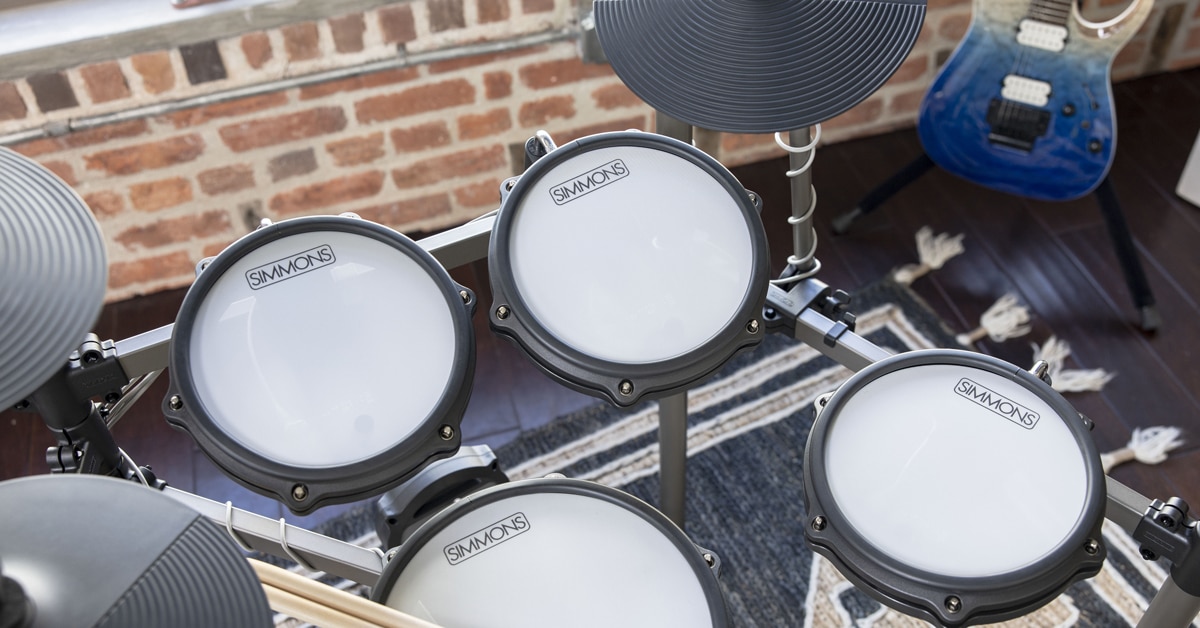Imagine having a drum kit that contains a near limitless choice of snares, toms, kicks, and cymbals plus a cornucopia of percussion sounds. Picture having hundreds of drum kits that can be instantly accessed to match any music genre or performance space with the touch of a button. Envision playing complex, multi-drum parts that would be physically impossible for mere mortals. All this and more is possible with an electronic drum kit.
In this guide we’ll walk you through the full range of electronic drumming gear available today. You’ll also learn all about drum machines, percussion controllers, and the latest trends in electronic drumming—including the growing popularity of “hybrid” electronic-acoustic drum kits equipped with acoustic drum triggers and/or percussion controllers. We’ll also discuss the challenges of making the switch from traditional drums to an electronic drum set.
Table of Contents
The Advantages of Going Electronic
How Electronic Drum Sets Work
A Brief History of Electronic Drums
Drum and Cymbal Pads, Triggers, and Mesh Heads
Drum Modules
Making the Transition from Acoustic to Electronic Drumming
The Best of Both Worlds: Electronic-Acoustic “Hybrid” Kits
Electronic Drum Amplification and Monitoring Systems
Drum Machines
Percussion Controllers
To Plug In or Not?
The Advantages of Going Electronic
Electronic drums allow you to tap into an endless variety of sounds; incorporate pre-recorded percussion phrases and songs into performances; easily add effects processing like reverb and delay; and play or practice anytime and anywhere with headphones.
Unlimited Sounds on Tap: No matter the musical setting, electronic drums kits offer a near-limitless range of sounds to meld with any music genre. Ideal for drummers who work in a wide range of music styles, it’s easy to dial in drum sounds to match any band be it a pop quartet, reggae band, jazz combo, or R&B horn band. Because you no longer need mics to capture your drum kit’s sounds, setup is faster, and the clutter of all those mic stands is eliminated. The absence of mics also eliminates sound bleed from other instruments and the possibility of feedback. It’s also easier to control the volume of an electronic kit in small venues and houses of worship where you need to keep a lid on your decibels.
Studio and Songwriting Versatility: With electronic kits you can easily edit your performance, adjusting timing and sounds to better suit your recording. Editing your entire performance or just a few notes is a relatively easy process, and with the vast array of sounds at your command, adding percussive sweetening can elevate a track from okay to extraordinary. Since your recorded performance can be captured as MIDI data, mixing and editing your drum performance is much more straightforward than slicing and dicing audio tracks.
In the recording studio, electronic drums let you plug directly into the mixing board, making it quick and easy to get a good drum sound without setting up a single microphone. Imagine not having to arrive hours early at the studio to work with the engineer on getting your sound right. Instead you can focus on playing the drums.
Portable and Compact: Electronic drum kits are more compact and portable than traditional drum sets. They typically store and travel easily in a couple of soft bags or cases, and take up less room in your practice space, band van, and on crowded stages.
Practice and Learning Benefits: Most electronic kits have built-in preset drum patterns that can be helpful in learning to play. Playing along with these patterns can help build the muscle memory and coordination needed to become a solid drummer. Some drum modules have specific learning tools and metronome functions that will help new drummers develop their timing and ability to maintain a groove. An auxiliary input and/or USB connector built into the sound module allows the connection of external music players, iOS devices, and computers, letting you play along with your favorite songs and artists and edit sounds using external software and apps.
How Electronic Drum Sets Work
Electronic drum kits require two sets of components: the transducers—more commonly referred to as the pads or trigger pads—and the trigger interface or module. The pads can range from a rubber playing surface with the transducer embedded inside the housing, or a drum shell with a mesh or woven head and an internally mounted, replaceable trigger.
- Regardless of the type of pad, they function the same way. When the pad is struck, the transducer sends an impulse to the module, and plays the note assigned to that channel. When hit harder, more signal is sent to the module increasing the volume, and when hit lighter, a quieter sound is played to emulate the dynamics of playing an acoustic drum or instrument.
- The most sophisticated modules create extremely nuanced sounds that accurately mirror the drummer’s technique, even when using brushes.
- Hybrid sets are also becoming common, as the cost of quality trigger modules has gone down, while the technology has gotten better. More and more drummers are incorporating either a multi pad such as the Yamaha DTX Multi 12 or Roland SPDSX into their acoustic drum set, or adding a set of acoustic triggers such as the ddrum Red Shot Trigger Pack and one of the many available trigger modules.
Drum and cymbal pads often have multiple sensors mounted beneath their playing surface. This allows the module to reproduce the sounds created by striking various parts of the instrument such as the head or rim of a snare drum, or the sound of bell, bow, or edge hits on a cymbal.
Electronics mean that today's drummer is no longer limited to playing conventional drum and percussion sounds. Now drummers can trigger funk bass, screaming lead guitar, thunder and lightning sounds, a Brazilian percussion section—all with a pair of sticks or their hands and some electronic drum pads. The only limitations are the sounds in your chosen drum module, also referred to variously as a sound module, percussion module, or "brain." Using MIDI, it's also possible to trigger sounds from any enabled sound module or keyboard. More advanced modules allow you to upload huge sound libraries. We’ll discuss modules in greater depth below.
A Brief History of Electronic Drums
The first electronic drum set has been attributed to Graeme Edge of the Moody Blues. He worked with Brian Groves from Sussex University, building a kit with rubber pads and sensors that was a primitive forerunner of today’s digitally controlled electronic drums. Used in the song “Procession” on the 1971 album, Every Good Boy Deserves Favor,” the kit was connected to a bank of sequencers and according to Edge, “The electronic drums inside looked something like spaghetti. When it worked it was superb, but it was before its day, because it was so sensitive..."
In the mid-1970s, the Syndrum, the first commercially available electronic drums, were introduced. Available in three configurations: single, twin or quad, they were soon adopted by drummers such as Keith Moon, Carmine Appice, Terry Bozzio, Jeff Porcaro, and many more. One of the most famous Syndrum parts is heard on the intro to “Let the Good Time Roll” on the Cars’ 1978 self-titled debut album.
Beginning in the late 1970s, the Simmons company began producing electronic drum sets, and its popular SDS-5 model with hexagonal pads became a hallmark of ‘80s rock sounds thanks to its use by Spandau Ballet, Duran Duran, Wang Chung, Def Leppard, Rush, and many more pop and rock acts. Other companies, notably Roland and Yamaha, soon joined the fray introducing their own models. These electronic drums were similar to today’s entry-level kits, having rubber pads for triggers that were velocity-sensitive, and producing sound by using single or multi-layered sampling.
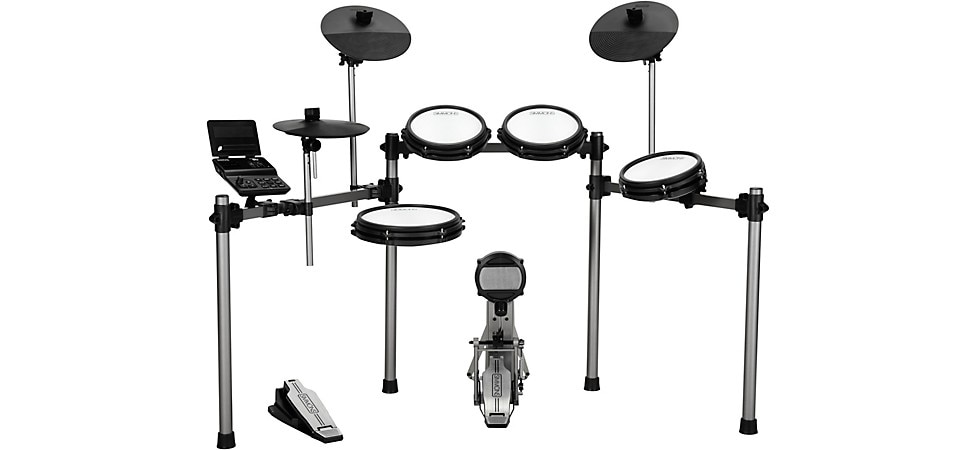
Equipped with mesh heads, the Simmons Titan 50 Electronic Drum Kit offers 25 inspiring drum kits, a dedicated app and helpful on-board learning tools.
Drum and Cymbal Pads, Triggers, and Mesh Heads
Electronic drums have come a long way since since their appearance in the late 1970s, when playing them felt a lot like playing on a Formica tabletop. Playing these early e-drums was very fatiguing to the hands, wrists, and arms over the course of a long gig. Electronic drums today offer much improved feel and response, using either rubberized pads or mesh heads.
Trigger pads or mesh heads can have up to three sensors. Single-sensor heads trigger a single sound, while dual- or three-trigger heads can trigger multiple sounds based on what part of the drum or cymbal is struck.
Rubber pads have rebound and feel that’s similar to traditional practice pads. Unlike acoustic drum heads and electronic mesh heads, rubber pads tend to have a similar feel from one pad to the next. Due to this feel consistency, rubber pads can be a good choice for triggering loops and sustained tones. They are generally used in more affordable electronic drum sets.
Mesh heads have a firm woven surface that responds more like an acoustic drum head, albeit with slightly enhanced rebound that arguably makes them a little easier to play than acoustic drums. Many mesh heads can be tuned to your preferred tension with a drum key, and are usually more sensitive to nuanced playing touch than pads. They also tend to be more costly than rubber pads.
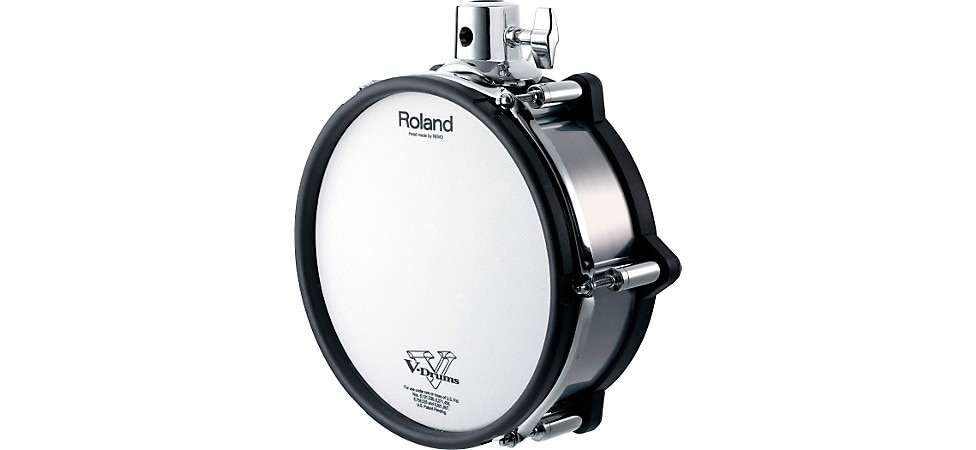
The Roland V-Pad 10” Tom has dual triggers on the head and rim, and offers more natural feel thanks to its mesh head.
Electronic cymbal pads are usually shaped like real cymbals or, in some cases, like a portion of a cymbal. Some recent innovations, such as Roland's most recent V-Cymbals, offer swinging motion, inertia, and the ability to choke the cymbal. Dual- and three-zone cymbals with separate triggers for the multiple cymbal playing surfaces allow a more realistic playing experience and allow you to use all your cymbal playing techniques.
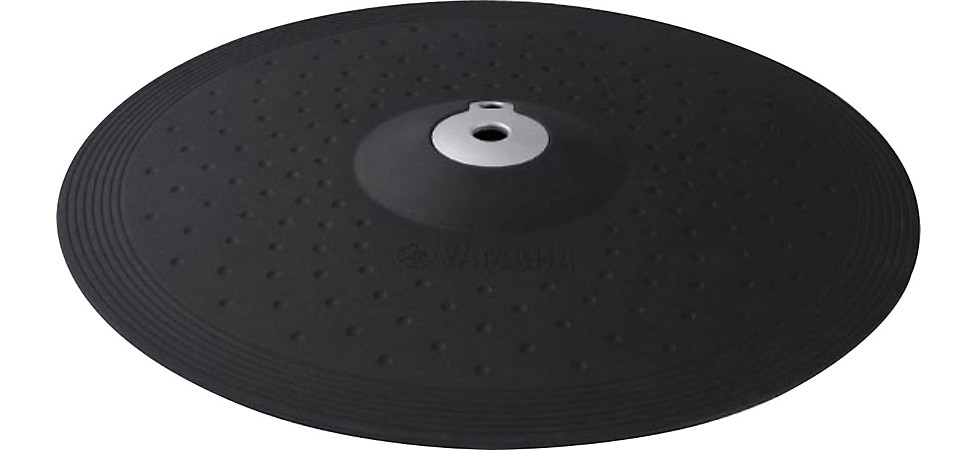
Yamaha’s PCY155 3-Zone Electronic Cymbal Pad has sensors on the edge, bow, and cup zones for highly nuanced cymbal sounds and a very natural feel.
Electronic hi-hats have also made great strides. Multi-zone hi-hats are now available that produce a great range of sounds and permit realistic, expressive playing by responding to open- and closed-position techniques.
Drum Modules
The drum module is the brain of the electronic drum kit. Modules vary in the type, number, and quality of the sounds they include, and most have a variety of instrument and special effects sounds as well as drum and percussion sounds. Some offer independent volume levels for each trigger to create custom live or studio mixes. Modules usually offer a choice of preset drum kits that are optimized for specific music genres such as jazz, rock, Latin, hip-hop, and many more music styles. A simple button push instantly calls up a whole new kit. Many modules allow you to build your own custom kits choosing from the available toms, snares, kick drums, and cymbals contained in the module. Premium modules let you download sounds from extensive online libraries, making your sonic options near limitless.
Here are the key features and capabilities to consider when comparing modules:
Sounds: There’s usually a direct relationship between the price of a drum module and the quality and variety of sounds it offers. Top-notch modules include all the standard drum set sounds you would expect, but also offer many other percussion instruments, bells, wood blocks, special effects, non-percussion instruments and much more. High-end modules also allow you to edit and create your own sounds. As noted earlier, modules that have download capabilities extend your sound options into the stratosphere.
Preset Patterns: Every module has a selection of preset patterns that are usually short two-bar patterns or drum parts that are often related to specific drum kits or music styles. As mentioned earlier, these can be valuable learning tools as well as a source of inspiration in creating your own unique drum parts. Many modules include full play-along tracks for both fun and practice.
Natural Feel and Sound: The best modules offer fast and accurate trigger response that gives drummers the same feedback they get from an acoustic kit. In other words, the module responds accurately to nuances in your playing technique giving you audio feedback that closely parallels your playing. The sensitivity and velocity of the module’s response can usually be tweaked to give you a more realistic playing experience. Many modules let you adjust the EQ of individual drums and cymbals for a balanced mix. They also often include ambience effects to improve your overall sound when playing in difficult performance or studio spaces.
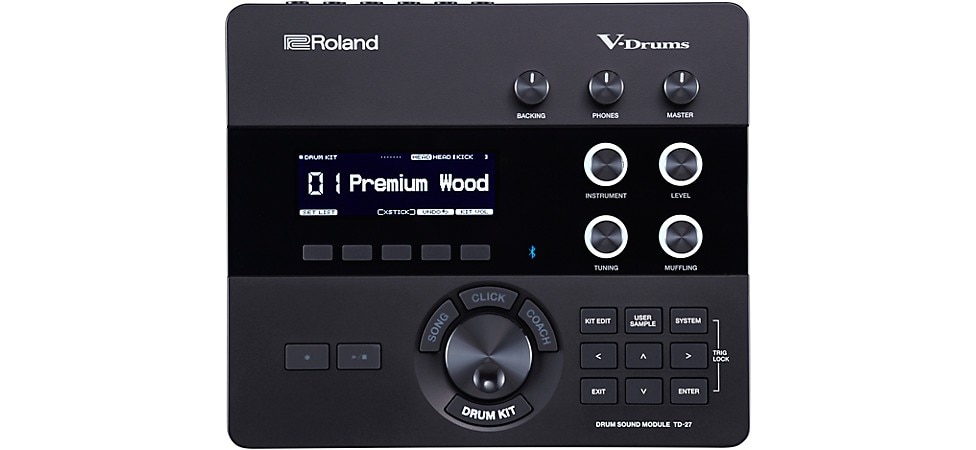
The Roland TD-27 Drum Module is loaded with acoustic drum and percussion sounds.
Look for a module that gets good marks for its positional sensing—the ability to accurately respond to where you’re playing on snares or cymbals that have multiple triggers. The best modules reproduce your playing dynamics with subtle sound variations. The module’s performance in reproducing cymbal sounds is especially critical. Crash shots should have the power you’d expect from an acoustic crash cymbal. Similarly, delicate swells and brush sounds should be reproduced accurately. The transitional sounds on hi-hats as you slowly move from the open to closed position should be smooth. The module should be able to authentically reproduce the sounds of playing in every hi-hat position from half open to slightly open to closed.
On drums, the sound of open rolls, buzz rolls, and flams should remain continuous and smooth between individual hits. Snare buzz resonances should sound realistic too. In auditioning an electronic kit, close your eyes and focus on its sound. Do the drums sound real? Can you hear realistic tom resonance? Does the kick drum have the “whomp” of an acoustic bass drum?
Connectivity and Expansion: If you plan to expand your electronic kit with more pads and triggers in the future, be sure the module has enough connectors to allow this. A USB port lets you send MIDI data to external PCs and digital audio interfaces and workstations, giving you access to wide range of music software. Audio inputs for connecting MP3 or CD players let you practice and play along with your favorite music. Multiple outputs that can send your performance simultaneously to a mixer and recorder can be useful in both live and studio settings. Also be sure that the outputs will support the type of amplification system you plan to use.
Making the Transition from Acoustic to Electronic Drumming
Drummers accustomed to the feel and response of their traditional acoustic drum set sometimes have difficulty transitioning to electronic drumming. Here are the main challenges and potential solutions:
Pad Feel and Touch: The rebound, attack characteristics, and overall stick response of pads or mesh head are decidedly different from their acoustic counterparts. Although mesh heads allow adjusting their tension, as with rubber pads, there is no getting around the need for adjusting your playing dynamics and stick technique to match their response. Altering technique is even more difficult for hand-percussion players who will find pads quite disorienting. However, there are controllers available for hand percussion that offer a more real-world feel.
Latency: Although MIDI is very fast, capable of processing hundreds of notes per second, you still may experience a slight lag between your sticking and the sound you hear. This is mostly caused by your preconditioning from playing acoustic drums. With time and practice on an electronic kit, this perception of a lag will diminish.
Distant Sound: Accustomed to hearing the sound of their performance emanating directly from their drum kit, drummers can find the electronic kit’s output through PA speakers many feet away distorienting. A small pair of monitor speakers mounted to the drum rack, or in-ear monitors can help eliminate this issue. We will address various monitoring systems below.
The Best of Both Worlds: Electronic-Acoustic ”Hybrid” Kits
Some drummers may never get completely comfortable with an electronic kit. Yet they would love to expand their artistic options with the many sounds possible using a drum module. By equipping your traditional kit with a set of acoustic triggers, you can enjoy the benefits of digital drum modules while enjoying all the visceral feel of a full acoustic drum set.
Trigger pads such as the Roland BT-1 integrate easily with acoustic drum sets and are designed to prevent false triggering when you’re playing surrounding drums or pads. Triggers can be mounted on the rims or inside drums to capture their full range of sounds. Multi-trigger bundle packs are available such as the ddrum Red Shot Trigger Pack that include a complete set of drum-specific triggers. Some of these bundles also include cabling and adapters for integrating the triggers into your setup.
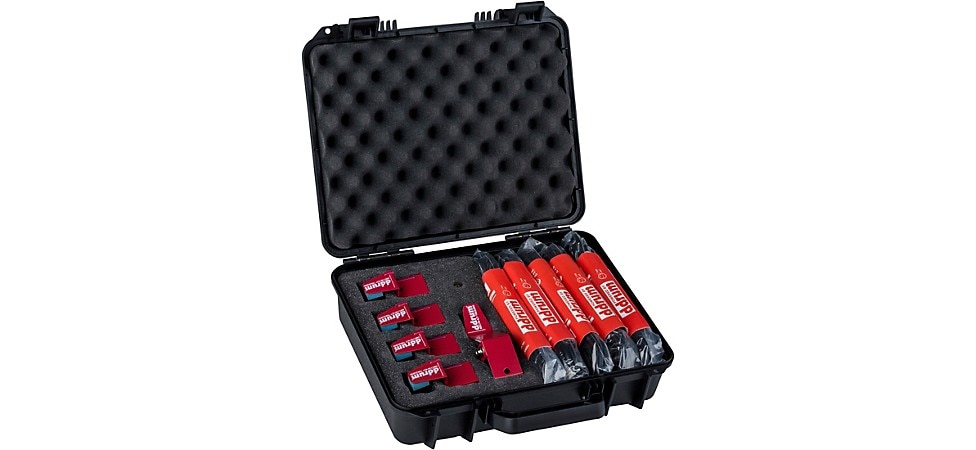
The ddrum Redshot Trigger Kit with Cables is a cost-effective way to convert conventional drum shells to electronic operation.
Drum triggering is simple to implement by attaching triggers to your acoustic drums and cymbals instead of using electronic drum pads. This means that you can play with all the sound and feel of your acoustic drums while harnessing the digital capabilities of your module.
Club work is a great application for acoustic-electric drum sets. Venues with challenging acoustics and unpredictable PAs can be much less difficult to play with a trigger-equipped drum set. With acoustic triggers, you need fewer mics on your kit, reducing sound bleed from other instruments. In conjunction with your drum module, this makes for clearer and punchier percussion. You can take even further control of your sound with your own drum amp, taking front-of-house sound out of the equation altogether.
As recording hardware and software evolves, studios are getting smaller and smaller and many just won’t do justice to an acoustic drum set. What's a drummer to do? It's simple: trigger the drums, record your overheads with cymbal mics, and capture your performance as both MIDI and audio from your drum sound module. If any of the drum sounds need to be changed you won't have to re-record—the engineer can just punch in new samples.
This just scratches the surface where acoustic triggering possibilities in the studio are concerned. Digital sampling and recording with both MIDI and acoustic offers a huge palette of material to choose from in mixing. Acoustic drum triggers put all the power of a sound module at your fingertips without having to adapt your technique to pads.
Electronic Drum Amplification and Monitoring Systems
To be heard, the sound module must be plugged into a mixer or amplifier with an audio cable. Especially when playing with other musicians, it's vital to have monitor speakers located close by so you can hear yourself. There are several self-contained drum amplifiers available that are especially made for electronic drums.
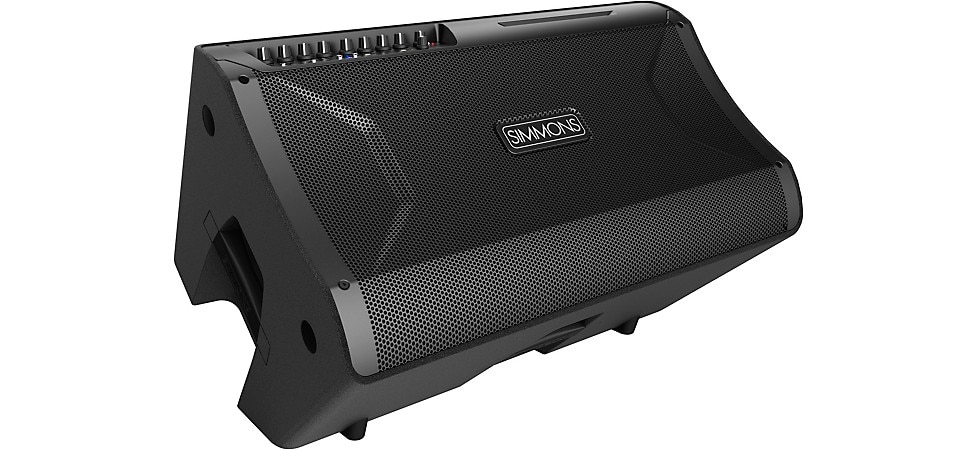
The Simmons DA212 Advanced Drum Amp offers high-powered high-fidelity sound, with 3 stereo line inputs and Bluetooth Audio input.
Drum Machines
Drum machines enjoyed a rocket-like ascension in popularity in the '80s and are by definition quite different from electronic drums. These beatboxes helped shape the sound of the era and still enjoy considerable popularity with hip-hop and rap producers as well as EDM bands and DJs. Even though software-based beat-building has become increasingly common, the tactile control surfaces of drum machines with their real knobs and buttons offer big workflow benefits.
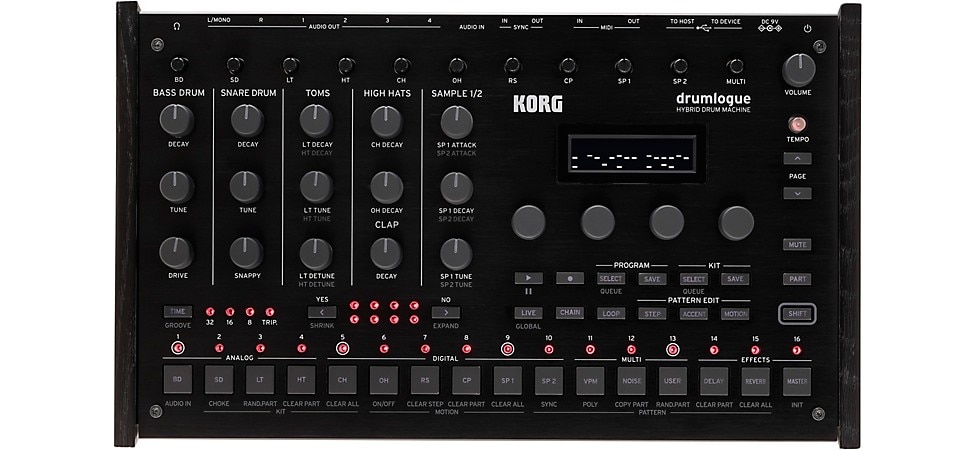
The Korg Drumlogue Hybrid Drum Machine combines the raw power of analog with the limitless flexibility of digital.
Some songwriters also use drum machines to build rhythm arrangements and grooves. Most of these devices have MIDI support so they integrate easily with keyboards, workstation arrangers, and electronic drum kits. They’re also still popular with solo and duo performers who need rhythmic backup. You’ll find drum machines that run the gamut from affordable and compact tabletop units that can be mastered relatively quickly to sophisticated devices with advanced sequencing functions and thousands of patterns, songs, samples, drum kits, and other instruments.
Most artists have returned to using real drummers in the studio for the feel that only a human can provide. However, some musicians continue to use drum machines as part of their sketch pad for composing songs. Drum machines are also used in cutting-edge genres like techno, jungle, and drum 'n' bass for playing extremely fast beats that are beyond the abilities of mere mortal drummers. They are also an important component of computer-based digital studios due to their ease of programming, their vast number of drum and percussion sounds, and onboard rhythms and grooves.
The '90s saw the rise of production and groove-creation gear such as the Akai MPC combined the features of a drum machine with sequencing and sampling capabilities. The cut-and-paste aesthetic of these souped-up beatboxes inspired a whole generation of artists. Trip-hop artist Tricky produced whole albums using little more than a Yamaha QY-22. Although these devices cover a whole lot more ground than simply creating rhythm tracks, they’re an important part of electronic beat building, with capabilities far beyond those built into electronic drum modules.
Percussion Controllers
Beside full-on electronic drum sets, there are also percussion controllers that allow you to trigger sounds from a small module or pad set. In some cases they can be played with your hands as well as sticks. An electronic percussion controller makes a great addition to a drum set for players who want the versatility of an electronic sound set without changing over to an electronic drum kit. The Roland SPD-SX Pro Sampling Pad is a percussion controller that has many of the features of complete electronic drum kits, and is extremely versatile.

The Roland SPD-SX Pro Sampling Pad has 1,550 sounds and 43 preset kits, with space for 157 user kits.
To Plug in or Not?
Few musicians would contend that electronic drums will ever replace acoustic drums. However, their huge sound sets, sequencing capability, and the many other benefits we’ve covered ensure that they're here to stay. Whether you're just starting out on your drumming journey, are an intermediate player looking to expand your percussive horizons, or a full-on pro drummer, you'll find that electronic drums have a whole lot to offer.
We want you to be pleased with your electronic drums purchase, and offer a 100% satisfaction guarantee and generous return policy so you can order your new gear with confidence.
After reading this guide, if you’re still not sure which electronic drum gear is right for you, we invite you to call one of our friendly and knowledgeable Gear Heads.





































































































































